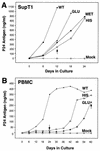Probing the importance of tRNA anticodon: human immunodeficiency virus type 1 (HIV-1) RNA genome complementarity with an HIV-1 that selects tRNA(Glu) for replication
- PMID: 12885895
- PMCID: PMC167254
- DOI: 10.1128/jvi.77.16.8756-8764.2003
Probing the importance of tRNA anticodon: human immunodeficiency virus type 1 (HIV-1) RNA genome complementarity with an HIV-1 that selects tRNA(Glu) for replication
Abstract
The initiation of human immunodeficiency virus type 1 (HIV-1) reverse transcription occurs at the primer binding site (PBS) that is complementary to the 3'-terminal nucleotides of tRNA(3)(Lys). Why all known strains of HIV-1 select tRNA(3)(Lys) for replication is unknown. Previous studies on the effect of altering the PBS of HIV-1 on replication identified an HIV-1 with a PBS complementary to tRNA(Glu). Since the virus was not initially designed to use tRNA(Glu), the virus had selected tRNA(Glu) from the intracellular pool of tRNA for use in replication. Further characterization of HIV-1 that uses tRNA(Glu) may provide new insights into the preference for tRNA(3)(Lys). HIV-1 constructed with the PBS complementary to tRNA(Glu) was more stable than HIV-1 with the PBS complementary to tRNA(Met) or tRNA(His); however, all of these viruses eventually reverted back to using tRNA(3)(Lys) following growth in SupT1 cells or peripheral blood mononuclear cells (PBMCs). New HIV-1 mutants with nucleotides in U5 complementary to the anticodon of tRNA(Glu) remained stable when grown in SupT1 cells or PBMCs, although the mutants grew more slowly than the wild-type virus. Sequence analysis of the U5 region and the PBS revealed additional mutations predicted to further promote tRNA-viral genome interaction. The results support the importance of the tRNA anticodon-genome interaction in the selection of the tRNA primer and highlight the fact that unique features of tRNA(3)(Lys) are exploited by HIV-1 for selection as the reverse transcription primer.
Figures






Similar articles
-
Forced selection of tRNA(Glu) reveals the importance of two adenosine-rich RNA loops within the U5-PBS for SIV(smmPBj) replication.Virology. 2007 Sep 30;366(2):330-9. doi: 10.1016/j.virol.2007.04.025. Epub 2007 Jun 1. Virology. 2007. PMID: 17543363 Free PMC article.
-
Identification of a sequence within U5 required for human immunodeficiency virus type 1 to stably maintain a primer binding site complementary to tRNA(Met).J Virol. 1997 Jan;71(1):207-17. doi: 10.1128/JVI.71.1.207-217.1997. J Virol. 1997. PMID: 8985340 Free PMC article.
-
Mutations in both the U5 region and the primer-binding site influence the selection of the tRNA used for the initiation of HIV-1 reverse transcription.Virology. 1996 Aug 15;222(2):401-14. doi: 10.1006/viro.1996.0437. Virology. 1996. PMID: 8806524
-
HIV-1 reverse transcription initiation: a potential target for novel antivirals?Virus Res. 2008 Jun;134(1-2):4-18. doi: 10.1016/j.virusres.2007.12.009. Epub 2008 Feb 6. Virus Res. 2008. PMID: 18255184 Review.
-
Initiation of HIV-1 reverse transcription and functional role of nucleocapsid-mediated tRNA/viral genome interactions.Virus Res. 2012 Nov;169(2):324-39. doi: 10.1016/j.virusres.2012.06.006. Epub 2012 Jun 18. Virus Res. 2012. PMID: 22721779 Review.
Cited by
-
The Interaction between tRNA(Lys) 3 and the primer activation signal deciphered by NMR spectroscopy.PLoS One. 2013 Jun 6;8(6):e64700. doi: 10.1371/journal.pone.0064700. Print 2013. PLoS One. 2013. PMID: 23762248 Free PMC article.
-
Forced selection of tRNA(Glu) reveals the importance of two adenosine-rich RNA loops within the U5-PBS for SIV(smmPBj) replication.Virology. 2007 Sep 30;366(2):330-9. doi: 10.1016/j.virol.2007.04.025. Epub 2007 Jun 1. Virology. 2007. PMID: 17543363 Free PMC article.
-
HIV-1 designed to use different tRNAGln isoacceptors prefers to select tRNAThr for replication.Virol J. 2006 Sep 26;3:80. doi: 10.1186/1743-422X-3-80. Virol J. 2006. PMID: 17002807 Free PMC article.
-
Defective replication in human immunodeficiency virus type 1 when non-primers are used for reverse transcription.J Virol. 2005 Jul;79(14):9081-7. doi: 10.1128/JVI.79.14.9081-9087.2005. J Virol. 2005. PMID: 15994802 Free PMC article.
-
Forced selection of a human immunodeficiency virus type 1 variant that uses a non-self tRNA primer for reverse transcription: involvement of viral RNA sequences and the reverse transcriptase enzyme.J Virol. 2004 Oct;78(19):10706-14. doi: 10.1128/JVI.78.19.10706-10714.2004. J Virol. 2004. PMID: 15367637 Free PMC article.
References
Publication types
MeSH terms
Substances
Grants and funding
LinkOut - more resources
Full Text Sources
Miscellaneous

